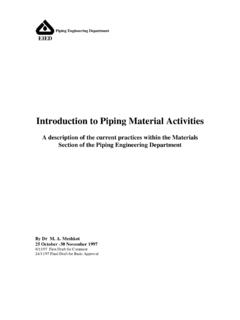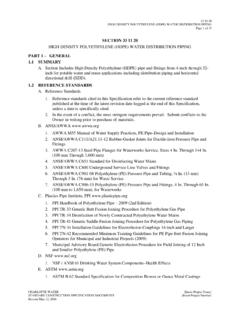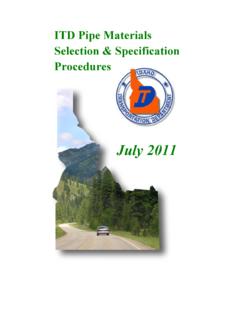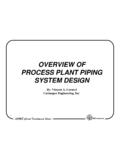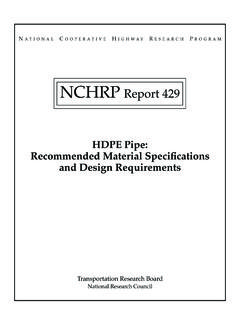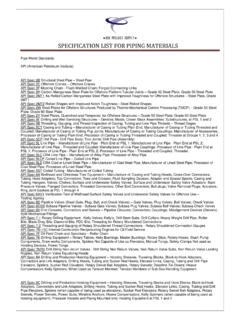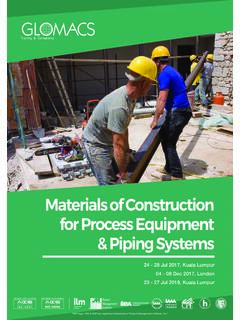Transcription of Pipeline Standard and Construction Specifications
1 Page 1 of 22 ODNR DSWR Pipeline Standard 12 3 13 Pipeline Standard and Construction Specifications Note: This technical Standard has been developed by the Ohio Department of Natural Resources, Division of Soil and Water Resources in order to recommend what is considered best practice for the protection of soil, water and related resources during Pipeline Construction . These are not to be considered as mandatory requirements unless cited by other laws, rules or legal agreements. Users are encouraged to use them as guidance for development of plans, on site practices and implementation or for remediating problem areas. I. Description A line of pipe with valves, pumps, and control devices used for the conveying of liquids, gases, or finely divided solids.
2 Pipelines convey oil, gasoline, gas, water, or any other liquefied product. This specification provides measures intended to limit the impact of the Pipeline Construction on agricultural productivity or on other lands where maintaining the natural soil and drainage attributes is important. II. Condition Where Practice Applies This practice applies where it is desirable or necessary to convey liquid or gaseous products in a closed conduit from one point to another point. III. Definition of Terms Agricultural Land Land which is presently under cultivation; land which has been previously cultivated and not subsequently developed for non agricultural use; and cleared land which is capable of being cultivated. It includes land used for cropland, hayland, improved pastureland, managed woodlands, truck gardens, farmsteads, commercial agricultural related facilities, feedlots, livestock confinement systems, land on which farm buildings are located, and land in government set aside programs.
3 Best Management Practice Any structural, vegetative or managerial practice (BMP) used to treat, prevent or reduce soil erosion or to capture pollutants such as sediment. Such practices may include temporary seeding of exposed soils, Construction of retention basins for storm water control and scheduling the implementation of all BMP s to maximize their effectiveness. Cropland Land used for growing row crops, small grains, or hay; includes land that was formerly used as cropland but is currently in a government set aside program, and pasture land formerly used as cropland. Inspector A person qualified by education and experience for the purpose of evaluating Pipeline Construction in relation to soils removal and replacement, drainage repairs, corridor restoration and other items identified in this Standard .
4 This person is sometimes retained by the Pipeline company for the above purposes, but may be a third party that is mutually agreed upon by the landowner and the Pipeline company. Landowner Person(s) holding legal title to property on the Pipeline route from whom the Pipeline company is seeking, or has obtained, a temporary or permanent easement. Landowner s Designate Any person(s) legally authorized by a landowner to make decisions regarding the mitigation or restoration of agricultural impacts to such landowner's property. Non Agricultural Land Any land that is not "Agricultural Land" as defined above. Page 2 of 22 ODNR DSWR Pipeline Standard 12 3 13 Pipeline The Pipeline and its related appurtenances.
5 Pipeline Company The entity responsible for installing the Pipeline , its successors, and assigns, on its own behalf and as operator of the company. Right of Way Includes the permanent and temporary easements that the Pipeline company acquires for the purpose of constructing and operating the Pipeline . Slope Breaker A ridge or channel constructed diagonally across a utility right of way or a road (water bar) that is subject to erosion. Subsoil Subsoil is defined as the soil material that starts at the bottom of the topsoil to a depth of three feet. Exceptions to this are soils where fractured bedrock or hard bedrock is encountered before three feet. Subsurface Drain or Drainage Any artificial system of pipes or conduits designed to intercept, collect, and convey excess soil moisture to a suitable outlet.
6 These may include: clay and concrete tile, vitrified sewer tile, corrugated plastic tubing, and stone drains. Surface Drains Any surface drainage system such as shallow surface field drains, grassed waterways, open ditches, or any other conveyance of surface water. Tenant Any person lawfully residing on or in possession of the land. Topsoil The upper most part of the soil commonly referred to as the plow layer, the A layer, or the A horizon, or its equivalent in uncultivated soils. It is the surface layer of the soil that has the darkest color or the highest content of organic matter (as Identified in the USDA County Soil Survey and verified w/ right of way samples). Topsoil is described as all surface and near surface soil horizons (layers) that have a moist Munsell color value of 4 and chroma of 3 or darker and a clay content increase of 10% or less between the individual horizons.
7 On agricultural land at least the top eight inches will be considered topsoil. Horizons with up to a twenty five percent mixing of the subsoil into the topsoil by agricultural processes will still be considered topsoil. In areas demonstrating substantial soil erosion, topsoil colors may be lighter than a moist Munsell color value of 4 and chroma 3. In these areas the top 8 inches will be considered topsoil. Surface horizons with a moist Munsell color value of 4 and chroma of 3 or darker in forested areas that have not been plowed are typically thinner. In these areas the top six inches will be considered topsoil. In areas where the above conditions do not apply, the top eight inches will be considered topsoil on agricultural land and the top six inches will be considered topsoil on forested land that has not been plowed.
8 Trench Breaker Trench breakers (also known as trench plugs) are barriers placed within an open Pipeline excavation in order to slow flow and reduce erosion in the trench and also to prevent the trench from becoming a subsurface drainage path. IV. Planning Phase A. Construction Plans and Maps The Pipeline company shall provide the landowner general Construction plan maps with the following information concerning agricultural areas/uses: 1. Pasture/Grazing areas including unimproved grazing areas (brushy or wooded land used by livestock), permanent open pasture (land devoted only to pasture use, not suited to tillage Page 3 of 22 ODNR DSWR Pipeline Standard 12 3 13 rotation), improved pasture (including tillable rotation pasture/hayland), and livestock fence lines.
9 2. Cropland areas including hayland, rotation cropland, long term cropland and agricultural lands enrolled in either the annual set aside or the Conservation Reserve Program (CRP) of the Consolidated Farm Service Agency. Such lands will be identified through consultation with the offices of the Consolidated Farm Service Agency and the county Soil and Water Conservation District. 3. Unique Agricultural Lands, which include specialty cropland (vegetables, berries, etc.), orchards, vineyards, maple sugarbushes, organic mucklands, and permanent irrigation systems. The areas mentioned above will be identified with the help of the County Soil and Water Conservation Districts. B. Sensitive Agricultural Soils Sensitive agricultural soils are defined as areas of cropland, hayland, or pasture that are more susceptible than other agricultural soils to Construction disturbance due to slope, relative soil wetness, and/or shallowness to bedrock.
10 Wetness conditions are the result of factors such as landscape position, soil texture, seasonal water table and/or slowly permeable subsoil horizons ( , areas of laterally draining subsoils). All sensitive agricultural soils including, but not limited to, those identified in the county soil survey as fragipans, lacustrine soils, dense basal tills, soils with a seasonally high water table, or soils with less than 5 feet of depth to bedrock are to be located and identified on the project map using the following codes: 1. "SE" designates the general area of soils sensitive to erosion due to R O W factor(s) of slope and/or the texture of exposed soil. 2. "SW" designates the general area of soils susceptible to soil horizon wetness as described above.



